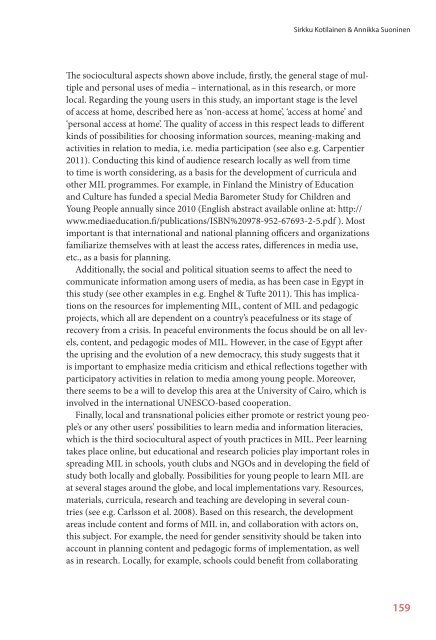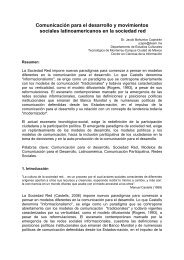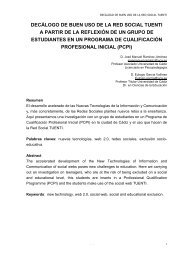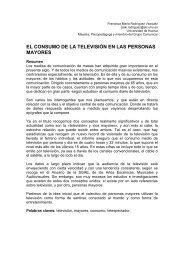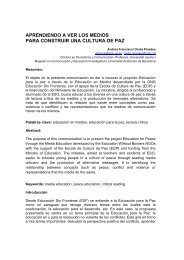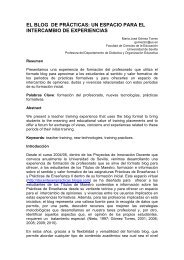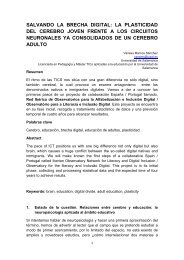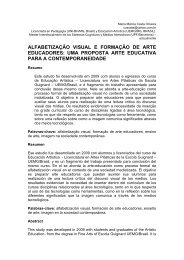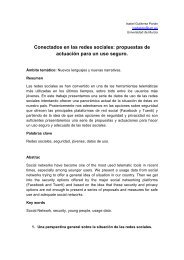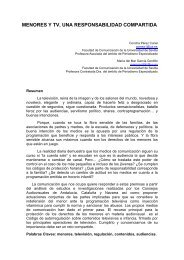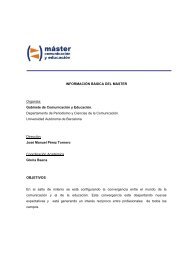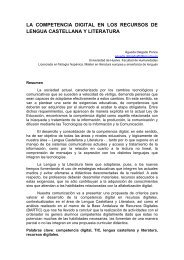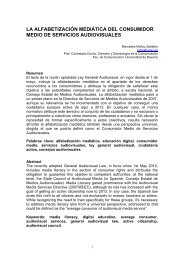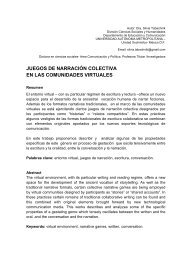- Page 1:
MILID Yearbook 2013A Collaboration
- Page 5 and 6:
ContentForeword 7Alton Grizzle, Jor
- Page 8 and 9:
Magda Abu-FadilQatar Educators Lear
- Page 10 and 11:
Part 1. The UNITWIN Cooperation Pro
- Page 13 and 14:
Alton Grizzle, Jordi Torrent & Jos
- Page 15:
Alton Grizzle, Jordi Torrent & Jos
- Page 21 and 22:
IntroductionNew Approachesand Chall
- Page 23 and 24:
Sherri Hope Culvercreate a bridge t
- Page 27 and 28:
Media and Information Literacyand I
- Page 29 and 30:
Paulette Stewart & Olivia Bravoexce
- Page 31 and 32:
Paulette Stewart & Olivia BravoTabl
- Page 33 and 34:
Paulette Stewart & Olivia BravoRefl
- Page 35 and 36:
Paulette Stewart & Olivia BravoTeac
- Page 37:
Paulette Stewart & Olivia Bravowell
- Page 40 and 41:
Li Xiguangthan a factory, encouragi
- Page 42:
Li XiguangFrom “Tedious Classroom
- Page 45 and 46:
Li XiguangExample One of Questions
- Page 47 and 48:
Li Xiguang3) Caravan Journalism Cla
- Page 49:
Li XiguangA: injustice.Q: what if a
- Page 54 and 55:
Rogério de Almeidaor pastime, cine
- Page 56 and 57:
Rogério de Almeidafully aware of h
- Page 59 and 60:
Rogério de AlmeidaIn this sense, R
- Page 61:
BuildingMILID fromthe Local tothe N
- Page 64 and 65:
Michael Dezuanni & Hilary HughesThe
- Page 66 and 67:
Michael Dezuanni & Hilary Hughes•
- Page 68 and 69:
Michael Dezuanni & Hilary Hughes•
- Page 70 and 71:
Michael Dezuanni & Hilary HughesThe
- Page 72 and 73:
Michael Dezuanni & Hilary Hughespro
- Page 74 and 75:
Michael Dezuanni & Hilary Hughescam
- Page 77 and 78:
National Leadershipand Local Action
- Page 79 and 80:
Sherri Hope CulverThis article expl
- Page 81 and 82:
Sherri Hope Culverties are develope
- Page 83 and 84:
Sherri Hope Culverrespond to the in
- Page 85 and 86:
Sherri Hope Culver3) Integrating Me
- Page 87:
Sherri Hope Culverdefinitions allus
- Page 90 and 91:
Abdelhamid Nfissi(1) it shows how M
- Page 92 and 93:
Abdelhamid Nfissirich variety of in
- Page 94 and 95:
Abdelhamid Nfissihand to achieve fu
- Page 96 and 97:
Abdelhamid NfissiInternational Semi
- Page 98 and 99:
Abdelhamid NfissiBuckingham, D. (20
- Page 101 and 102:
Advancing MILIDJosé Manuel Pérez
- Page 103 and 104:
José Manuel Pérez Tornero, Cristi
- Page 105 and 106:
José Manuel Pérez Tornero, Cristi
- Page 107 and 108:
José Manuel Pérez Tornero, Cristi
- Page 109 and 110: José Manuel Pérez Tornero, Cristi
- Page 111 and 112: José Manuel Pérez Tornero, Cristi
- Page 113 and 114: José Manuel Pérez Tornero, Cristi
- Page 115: José Manuel Pérez Tornero, Cristi
- Page 118 and 119: Marwa Mohamed Nabil Abd El Moniem
- Page 120 and 121: Marwa Mohamed Nabil Abd El MoniemTh
- Page 122 and 123: Marwa Mohamed Nabil Abd El MoniemTh
- Page 124 and 125: Marwa Mohamed Nabil Abd El MoniemIm
- Page 127: MILID Week
- Page 130 and 131: Carolyn Wilson & Samy TayieThe Cana
- Page 132 and 133: Carolyn Wilson & Samy TayieThe week
- Page 135 and 136: IntroductionWhy a MILID YearbookPub
- Page 137 and 138: Ulla Carlssoninfluences have to be
- Page 139: Ulla CarlssonIt is particularly imp
- Page 143 and 144: Cultures of Media andInformation Li
- Page 145 and 146: Sirkku Kotilainen & Annikka Suonine
- Page 147 and 148: Sirkku Kotilainen & Annikka Suonine
- Page 149 and 150: Sirkku Kotilainen & Annikka Suonine
- Page 151 and 152: Sirkku Kotilainen & Annikka Suonine
- Page 153 and 154: Sirkku Kotilainen & Annikka Suonine
- Page 155 and 156: Sirkku Kotilainen & Annikka Suonine
- Page 157 and 158: Sirkku Kotilainen & Annikka Suonine
- Page 159: Sirkku Kotilainen & Annikka Suonine
- Page 163 and 164: Sirkku Kotilainen & Annikka Suonine
- Page 165 and 166: Educational Challenges in Timesof M
- Page 167 and 168: Guillermo Orozco, Eva Navarro & Agu
- Page 169 and 170: Guillermo Orozco, Eva Navarro & Agu
- Page 171 and 172: Guillermo Orozco, Eva Navarro & Agu
- Page 173 and 174: Guillermo Orozco, Eva Navarro & Agu
- Page 175: Guillermo Orozco, Eva Navarro & Agu
- Page 178 and 179: Divina Frau-Meigsand broadband medi
- Page 180 and 181: Divina Frau-Meigsfurther illustrate
- Page 182 and 183: Divina Frau-Meigsboard like service
- Page 184 and 185: Divina Frau-MeigsIntegrating Learni
- Page 186 and 187: Divina Frau-MeigsFigure 2. “Trans
- Page 188 and 189: Divina Frau-MeigsDesigned PresenceC
- Page 190 and 191: Divina Frau-MeigsFrau-Meigs, D. (20
- Page 193: Youth Engagingwith Media andCommuni
- Page 196 and 197: Jiwon YoonAs a consequence of the s
- Page 198 and 199: Jiwon YoonNorth Korea made her feel
- Page 200 and 201: Jiwon YoonRoad was screened at the
- Page 202 and 203: Jiwon YoonNote1 Part of this articl
- Page 204 and 205: Ibrahim SalehMany Egyptian elite yo
- Page 206 and 207: Ibrahim Salehthe nature of society,
- Page 208 and 209: Ibrahim Salehmunicating messages to
- Page 210 and 211:
Ibrahim Salehscholars believe that
- Page 212 and 213:
Ibrahim Salehanalysis was processed
- Page 214 and 215:
Ibrahim SalehBhuiyan, S.I., (2007)
- Page 216 and 217:
Ibrahim Salehsometimes competing le
- Page 218 and 219:
K.V. Nagaraj & Vedabhyas Kunduschoo
- Page 220 and 221:
K.V. Nagaraj & Vedabhyas KunduThe P
- Page 222 and 223:
K.V. Nagaraj & Vedabhyas Kunduuse o
- Page 224 and 225:
K.V. Nagaraj & Vedabhyas KunduIt is
- Page 226 and 227:
K.V. Nagaraj & Vedabhyas KunduFurth
- Page 228 and 229:
K.V. Nagaraj & Vedabhyas Kundu18 Ku
- Page 230 and 231:
Minou Fuglesang & Karen Marie Thuls
- Page 232 and 233:
Minou Fuglesang & Karen Marie Thuls
- Page 234 and 235:
Minou Fuglesang & Karen Marie Thuls
- Page 236 and 237:
Gerrit Beger, Priscillia Kounkou Ho
- Page 238 and 239:
Gerrit Beger, Priscillia Kounkou Ho
- Page 240 and 241:
Gerrit Beger, Priscillia Kounkou Ho
- Page 242 and 243:
Gerrit Beger, Priscillia Kounkou Ho
- Page 245 and 246:
Giving Children a VoiceWorldwide Ra
- Page 247 and 248:
Thomas RöhlingerRadijojo’s Work
- Page 249 and 250:
Thomas RöhlingerAll our work is no
- Page 251 and 252:
Thomas RöhlingerDecentralization:
- Page 253:
Thomas RöhlingerRecent Awards for
- Page 256 and 257:
Evelyn Seubert & Miomir Rajčevićr
- Page 259:
Media andInformationLiteracy andInt
- Page 262 and 263:
Alton Grizzleand Information Litera
- Page 264 and 265:
Alton Grizzleplatforms and common a
- Page 266 and 267:
Alton Grizzleties on media and info
- Page 268 and 269:
Jean-Pierre Ilboudo & Joëlle Matte
- Page 270 and 271:
Jose Reuben Q. Alagaran IIMedia and
- Page 272 and 273:
Jose Reuben Q. Alagaran IIThe Phili
- Page 274 and 275:
Andrea Cairola & Qingy ZengImplemen
- Page 276 and 277:
Andrea Cairola & Qingy Zengwith int
- Page 278 and 279:
Misako ItoThe MIL Curriculum for Te
- Page 280 and 281:
Sara Gabaiand Lifelong Learning. Th
- Page 282 and 283:
Sara Gabaithe founder of MILThailan
- Page 284 and 285:
Ramon TuazonInformation Literacy in
- Page 286 and 287:
Ramon Tuazon284Strategies for Imple
- Page 288 and 289:
Jagtar Singh & F. Woody HortonMedia
- Page 290 and 291:
Jagtar Singh & F. Woody Hortonlevel
- Page 292 and 293:
Jagtar Singh & F. Woody Horton9. Ra
- Page 294 and 295:
Cherrell Shelley-RobinsonSurvey of
- Page 296 and 297:
Cherrell Shelley-RobinsonThe most c
- Page 298 and 299:
Cherrell Shelley-Robinson(45.9% str
- Page 300 and 301:
APPENDIX: UNESCO MIL Curriculum for
- Page 302 and 303:
APPENDIX: UNESCO MIL Curriculum for
- Page 304 and 305:
APPENDIX: UNESCO MIL Curriculum for
- Page 306 and 307:
APPENDIX: UNESCO MIL Curriculum for
- Page 308 and 309:
APPENDIX: UNESCO MIL Curriculum for
- Page 311 and 312:
Handbook onthe Pedagogies of Mediaa
- Page 313 and 314:
Suvi Tuominen, Sirkku Kotilainen &
- Page 315 and 316:
Suvi Tuominen, Sirkku Kotilainen &
- Page 317 and 318:
Suvi Tuominen, Sirkku Kotilainen &
- Page 319:
Suvi Tuominen, Sirkku Kotilainen &
- Page 322 and 323:
Jordi Torrentwe support UNESCO’s
- Page 324 and 325:
Jordi Torrentthe networked universi
- Page 326 and 327:
Jordi TorrentCulture of PeaceI hope
- Page 329 and 330:
Media Literacy Policyin European Un
- Page 331 and 332:
José Manuel Pérez Tornero & Mirei
- Page 333 and 334:
José Manuel Pérez Tornero & Mirei
- Page 335 and 336:
José Manuel Pérez Tornero & Mirei
- Page 337 and 338:
José Manuel Pérez Tornero & Mirei
- Page 339 and 340:
José Manuel Pérez Tornero & Mirei
- Page 341 and 342:
José Manuel Pérez Tornero & Mirei
- Page 343 and 344:
José Manuel Pérez Tornero & Mirei
- Page 345 and 346:
José Manuel Pérez Tornero & Mirei
- Page 347 and 348:
José Manuel Pérez Tornero & Mirei
- Page 349 and 350:
José Manuel Pérez Tornero & Mirei
- Page 351 and 352:
José Manuel Pérez Tornero & Mirei
- Page 353 and 354:
José Manuel Pérez Tornero & Mirei
- Page 355:
José Manuel Pérez Tornero & Mirei
- Page 358 and 359:
Ibrahim SalehThe idea here is to of
- Page 360 and 361:
Ibrahim Salehdemnation (Moll, 2009)
- Page 362 and 363:
Ibrahim Salehself-actualizing, grow
- Page 364 and 365:
Ibrahim Salehthe curriculum, and th
- Page 366 and 367:
Ibrahim SalehDiscussion and Conclus
- Page 368 and 369:
Ibrahim SalehDe Vos, A.S. (ed.). (2
- Page 371 and 372:
Media Literacy in ArgentinaRoxana M
- Page 373 and 374:
Roxana Morduchowicz• There is a g
- Page 375:
Roxana MorduchowiczMedia literacy p
- Page 378 and 379:
Alexandre Le Voci SayadA significan
- Page 380 and 381:
Alexandre Le Voci SayadThe CEP Netw
- Page 382 and 383:
Alexandre Le Voci SayadEducommunica
- Page 384 and 385:
Magda Abu-Fadilcess the information
- Page 386 and 387:
Magda Abu-FadilSix years later and
- Page 388 and 389:
Magda Abu-FadilRania Khaled Al Huss
- Page 390 and 391:
Jun Sakamoto & Kyoko MurakamiFrame
- Page 392 and 393:
Jun Sakamoto & Kyoko Murakamiprojec
- Page 394 and 395:
Jun Sakamoto & Kyoko Murakamiformed
- Page 396 and 397:
Jun Sakamoto & Kyoko MurakamiPhotog
- Page 398 and 399:
Jun Sakamoto & Kyoko MurakamiPhotog
- Page 401 and 402:
Media Literacy as a Wayto Build Dem
- Page 403 and 404:
Ragna Wallmark1970s. During the pas
- Page 405:
Ragna WallmarkEnhancing media liter
- Page 408 and 409:
Jose Reuben Q. Alagaran IIpoint of
- Page 410 and 411:
Jose Reuben Q. Alagaran IIIn the pr
- Page 412 and 413:
Jose Reuben Q. Alagaran IIIn develo
- Page 414 and 415:
Jose Reuben Q. Alagaran IIRole Gene
- Page 416 and 417:
ContributorsPart IRogério de Almei
- Page 418 and 419:
K.V. Nagaraj, Dr, Professor, Pro Vi
- Page 420:
The UNITWIN Cooperation Programme o


